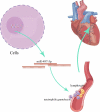Serum miR-497-5p serves as a diagnostic biomarker for acute coronary syndrome and predicts the occurrence of major adverse cardiovascular events after percutaneous coronary intervention
- PMID: 35302437
- PMCID: PMC9161957
- DOI: 10.1080/21655979.2022.2051885
Serum miR-497-5p serves as a diagnostic biomarker for acute coronary syndrome and predicts the occurrence of major adverse cardiovascular events after percutaneous coronary intervention
Abstract
This study aimed to investigate the diagnostic value of microRNA (miR)-497-5p in acute coronary syndrome (ACS) and its predictive value for the occurrence of adverse major adverse cardiovascular events (MACEs). Real-time quantitative polymerase chain reaction (RT-qPCR) was performed to detect the expression of serum miR-497-5p in 110 ACS patients and 82 controls. And miR-497-5p levels were found to be significantly elevated in the patients (P < 0.001). Pearson correlation coefficient confirmed that miR-497-5p was positively correlated with Gensini scores (r = 0.684). The area under the Receiver-operating characteristic (ROC) curve was 0.861, which significantly identified patients with ACS, and was confirmed by logistic regression (OR = 8.533, 95%CI = 4.113-17.787, P < 0.001). Kaplan-Meier and Cox regression was performed to evaluate the predictive value of miR-497-5p in the occurrence of MACEs during a 6-month follow-up after percutaneous coronary intervention (PCI) in patients with ACS. The results demonstrated that miR-497-5p was an independent predictor of MACEs (HR = 4.773, 95%CI = 1.569-12.036, P = 0.013) and that patients with high level of miR-497-5p were more likely to develop MACEs after PCI (long-rank P = 0.019). Finally, miR-497-5p positively correlated with endothelial proinflammatory and adhesion factors. Our study suggests that serum miR-497-5p is a potential diagnostic marker for ACS and its elevated levels can predict a high risk of MACEs in ACS patients after PCI. And this may be associated with vascular endothelial injury.
Keywords: acute coronary syndrome; clinical biomarker; miR-497-5p.
Conflict of interest statement
No potential conflict of interest was reported by the author(s).
Figures





References
-
- Porter A, Paradkar A, Goldenberg I, et al. Temporal Trends Analysis of the Characteristics, Management, and Outcomes of Women With Acute Coronary Syndrome (ACS): ACS Israeli Survey Registry 2000-2016. J Am Heart Assoc. 2020Jan7;9(1):e014721.PubMed PMID: 31852425; PubMed Central PMCID: PMCPMC6988167. - PMC - PubMed
-
- De Rosa R, De Rosa S, Leistner D, et al. Transcoronary Concentration Gradient of microRNA-133a and Outcome in Patients With Coronary Artery Disease. Am J Cardiol. 2017Jul1;120(1):15–24.PubMed PMID: 28511772. - PubMed
MeSH terms
Substances
LinkOut - more resources
Full Text Sources
Miscellaneous
